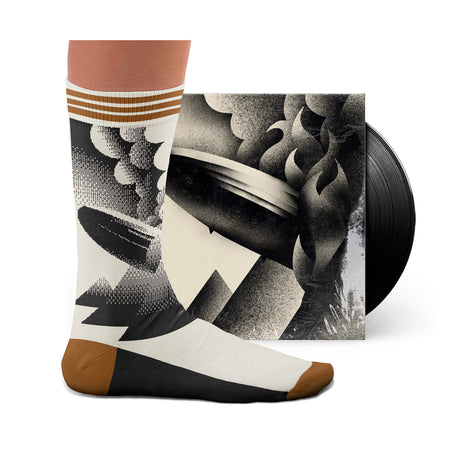


Las Meninas Socks
Artist: Diego Velázquez
Created: 1656
Dimensions (cm): 318 x 276
Format: Oil on canvas
Location: Museo del Prado, Madrid
An inception-type painting-in-painting, Velázquez's Las Meninas is one of the most dissected works in Western art. The fact that he may have invented the photobomb by shamelessly including himself in the frame is certainly a contributing factor.
Born in Seville in 1599, Diego Velázquez became one of the most prominent artists of the Baroque period, with a unique style that set him apart from his Italian and French contemporaries. His career took off when he moved to Madrid and found himself as a court painter for King Philip IV. His work would be highly influential to Manet and the Impressionists.
The relationship between illusion and reality was a central concern in the Spanish culture of the time, as his Baroque contemporary Cervantes would attest. In his decades as a portrayer for Philip's court, Velázquez became indispensable to the King. This might have emboldened him to break from the stiff normal portraits that typically defined royalty and produce an incredibly nuanced depiction of life in the court. It would turn into the most important painting of the Baroque.
It starts with the name, 'Las Meninas'. 'Meninas' is not a Spanish word, it's Portuguese for young girl. Why he would this word for the title of such important work is anyone's guess.
At first glance 'Las Meninas' is a portrait of the infanta. But, if he was depicting himself painting the infanta then she is facing the wrong direction, looking at us, as are most figures. So is Velázquez. This leads us to the elephant in the room. While it was not uncommon for artists to include themselves in their work, Velásquez shamelessly paints himself as a prominent figure. Many speculate that this was Velázquez's way of asserting his importance within the court. The red cross on his chest is the symbol of the Order of Santiago, a prestigious religious and military order. Exceedingly difficult to enter, he was admitted to the order in 1659 upon a decree of the king. no one is sure if this honour was awarded prior to the painting or if it had been a crafty way to influence the King's decision.
Although there are certainly many other characters and details for us to over-analyze, we'll end by focusing on the element that seems to restore some order in the apparent chaos painted by Velázquez.
While it may not immediately apparent whom most of the people depicted are looking at, there's a hint to keen observers. Reflected in the mirror at the back we see the figures of King Philip IV and his queen, Mariana of Austria, the only ones capable of commanding attention from all figures. This makes them the fourth wall, the beholders, but also makes us the royals. And the painters. Or maybe it's just Velásquez painting the infanta while looking at a giant mirror. Or maybe it's all just happening in the multiverse.
80% Combed Cotton, 17% Polyamide, 3% Elastane.
Made in Portugal using the most advanced craftsmanship to produce the finest seamless socks.
Wash inside out (40ºC/100ºF max). Do not tumble dry, iron.
80% Combed Cotton, 17% Polyamide, 3% Elastane.
We use seamless knitting to create a sock with no stitches.
Taille des chaussettes
| EU | 36-40 | 41-46 |
| UK | 4-7 | 7½-11½ |
| US M | 4½-7½ | 8-12 |
| US W | 6-9½ | 10-12½ |








